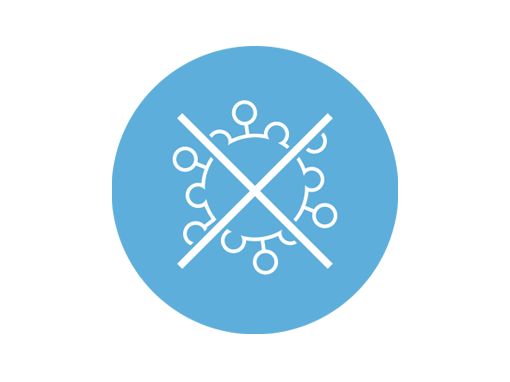Before the Wave: The Intelligent Coronavirus Early Warning System from IAV
One thing is clear about the coronavirus: The faster and more accurately outbreaks can be localized, the better they can be contained. IAV has developed a coronavirus early warning system that detects the virus in wastewater – much earlier than human tests can. This gives it a valuable head start.

What is required?
SARS-CoV-2 has the world firmly in its grip. This is not a one-time event: There have been nine other global pandemics in the last 65 years. In order to make optimal and informed decisions in the event of an emergency, excellent information tools are needed for governments and the public.

What is the objective?
To equip water management companies, cities and municipalities as well as industry with the necessary tools to make the evaluation of wastewater samples an integral part of pandemic control. Thus, we enable faster and more targeted action.

Our solution
The use of wastewater data enables a rapid and locally contained view of the situation. IAV offers an integrated systemic approach consisting of a tailored local model for optimal sampling, sample analysis and evaluation for your site.
Artificial intelligence in the fight against the virus
The system uses an intelligent and cloud-based Internet of Things (IoT) platform to synthesize and analyze the data, as well as an artificial intelligence (AI)-backed method to intelligently position devices in the wastewater system that can take samples automatically. After all, this is precisely where one of the major challenges lies when taking measurements in the widely ramified network of sewers: figuring out at which points samples should preferably be taken. To do this, the system integrates into its calculations both information about outbreaks in the past and socioeconomic data from social atlases, taking into account the strictest data protection standards. These provide information on factors such as population density, age structure or built-up areas. This creates an index model that calculates where there is a higher or lower probability of outbreaks and should therefore be prioritized for measurement. Example: In densely populated areas where residents live primarily in multifamily housing, the likelihood tends to be higher than in neighborhoods where detached single-family homes dominate the development.
Reducing the number of unreported cases
It is still disputed whether the wastewater samples also allow reliable conclusions to be drawn about the exact number of infections in a particular area. So far, however, they have been able to reliably determine whether infections are present or not. The method already has one major advantage. It also detects infections that human tests do not usually depict: those with a symptomless course.
Know-how from automotive engineering
With all these advantages, the system is just as interesting for municipalities as it is for large companies that want to detect outbreaks on their company premises at an early stage. At IAV, they receive the complete package of measurement, analysis and results and can view their data in a protected dashboard. For the system, IAV cooperates with the Institute for Urban Water Management at the Technical University (TU) Berlin and ORI Abwassertechnik GmbH. ORI supplies the samplers and the measurement technology, while IAV organizes the collection and analysis of the samples. In the process, IAV is using its know-how from automotive engineering. Machine learning and statistical methods, such as those used to create the index model, have been the engineering expert’s bread and butter for years. Pätsch explains: “In the automotive sector, IAV has long been used to processing data of different geneses and forms in a single system.” A capability that is now also being put to use to stay ahead of the next wave of coronavirus infections.
We provide all the services you need from one reliable partner
Positioning of sensors in the monitoring network
Uses: You can be sure that infection signals are detected reliably and accurately. IAV fuses measured value analyses with socio-demographic data of your city and the topology of your wastewater network. In this way, we determine the optimum position of measuring points in your wastewater system.
Provision of sampling equipment
Uses: Your measuring network is always ready for use and ready to provide information. IAV and our partners provide you with the sensors and sampling devices, take care of replacement devices, instruct your people in their operation or provide a team on site to do so.
Sample analysis
Uses: You get immediate access to high-quality results from sensor technology and sample analysis. IAV and our partners analyze your wastewater samples for SARS-COV-2 and other pathogens. You benefit from the latest developments in sample analysis.
Presentation and evaluation of results
Uses: You receive all the information you need to make your decision. IAV creates, hosts and links your urban dashboard. We combine wastewater monitoring results using Big Data analytics to assess the risk situation with catchment accuracy from current and historical data.
Early detection
Why use your sewer network for early detection?
Numerous projects have shown that SARS-CoV-2 can be reliably detected in wastewater and used as an indication for early warning.
Has the concept been tested in practice?
IAV has found examples in over 300 cities and towns to date where SARS-CoV-2 has been found via detection of corona RNA in various wastewater systems
How reliable is the analysis?
Samples are analyzed using the PCR method. False-positive test results are virtually excluded. A high sample frequency reduces the risk of overlooking infections.
What about data protection?
Data protection is not an issue with the wastewater samples: it is impossible to identify individuals from the wastewater sample.
Sampling
Why is it better to have several sampling points?
Multiple sampling points provide a detailed picture of the infection and counteract dilution effects. By tracking against the direction of wastewater flow, particularly affected areas (hot spots) can be identified.
How do we determine the optimal sampling location?
Optimal sampling locations are determined using IAV’s IndexModel.
What data does IAV need about my location?
GIS information for the sewer network and geo-referenced socio-demographic information that is typically available.
How often and by whom are samples taken?
Depending on the specific situation, samples should be taken at least every two days and analyzed immediately. Sampling is done by IAV or its partners.
Sample analysis
What steps are necessary to detect viruses in wastewater?
The detection of coronavirus is mainly done in three steps: the collection of wastewater, a concentration process to increase the density of the virus RNA fragments, and finally the microbial analysis PCR.
Who analyzes the samples?
All appropriate laboratories can analyze the samples. Important: sample analyses must be performed immediately after sample collection to provide early warning.
How is the virus detected?
After the preparatory steps, the virus is detected by PCR analysis.
What other values can be analyzed?
The technology is suitable for early detection of all pathogens and contaminants present in wastewater.
What kind of conclusion can be drawn from the analysis?
Depending on the availability of additional information (e.g. flow rate), positive PCR results can be converted into RNA concentrations in wastewater.


